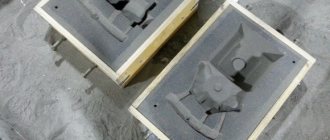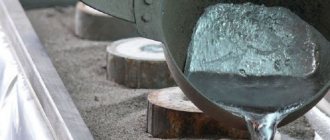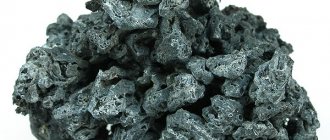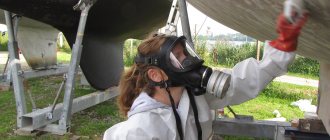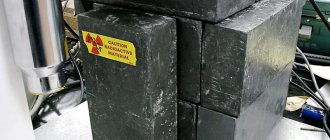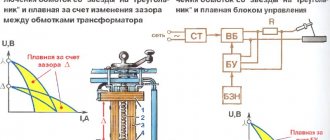Physical properties
At room temperature and without applying pressure, all substances are solid. But there is gallium, which already at 30 degrees of heat begins to deform and melts in your hands. Characteristics you can note:
- High plasticity. Only manganese, tin and zinc are fragile.
- Can be light or heavy. Compare aluminum with osmium.
- The melting point is very high. There are exceptions, for example, mercury, which is why it is used in classic thermometers.
- Color – gray, silver, bluish. Colored items, such as yellow or red, are rare.
- Increased conductivity of heat and electricity, especially in copper, is why copper wires are popular.
Plastic:
Most metals are ductile, meaning metal wire can be bent without breaking. This occurs due to the displacement of layers of metal atoms without breaking the bond between them.
The most ductile are gold, silver and copper. Gold can be used to make foil 0.003 mm thick, which is used for gilding products. However, not all metals are ductile. Wire made of zinc or tin crunches when bent; When deformed, manganese and bismuth hardly bend at all, but immediately break.
Plasticity also depends on the purity of the metal. Thus, very pure chromium is very ductile, but, contaminated with even minor impurities, it becomes brittle and harder. Some metals, such as gold, silver, lead, aluminum, osmium, can grow together, but this can take decades.
Classification and types of metals
There are pure, single-component structures and alloys. The most classic example is the different types of steel. They differ according to GOST in accordance with the addition of alloying additives. The higher the carbon content, the stronger the material. There is also a generally accepted distinction; below we present the subtypes.
Black
They are mined from metal ore. In production they occupy 90% of all raw materials. Usually these are cast iron and steel. To change the characteristics, more or less amount of carbon and alloying additives are added: copper, silicon, chromium, nickel. One of the very popular subspecies is stainless steel, which is distinguished by its shiny surface and unique properties - lightness, high strength and resistance to humidity and temperature changes.
What applies to non-ferrous metals
The second name is non-iron, that is, alloys do not contain iron, but consist of more expensive materials. Substances have different colors and have unique qualities:
- durability;
- long-term preservation of properties;
- the formation of an oxide film that prevents corrosion.
Thanks to this, certain varieties can be used in medicine, jewelry, the chemical industry, and in the manufacture of electrical wires. Non-ferrous metals include aluminum, zinc, tin, lead, nickel, chromium, silver, gold and others.
Copper and its alloys are popular metals
Copper ore was one of the first to be processed by man because it is subjected to the cold method of forging and stamping. Pliability has led to demand everywhere. Oxygen in the composition leads to a red tint. But decreasing the valency in various compounds will lead to yellow, green, blue color. Excellent thermal conductivity is considered an attractive quality - second only to silver, which is why it is used for wires. Connections can be:
- solid - in combination with iron, arsenic, zinc, phosphorus;
- with poor solubility with bismuth, lead;
- fragile - with sulfur or oxygen.
Metals include aluminum and alloys
Al was discovered in 1825 and is distinguished by its ease and simplicity in metalworking. It is made from bauxite, and the reserves of this rock are practically inexhaustible. Next, the element is combined in various proportions with copper, manganese, magnesium, zinc, and silicon. Less often with titanium, lithium, beryllium. Features depending on additives:
- good weldability;
- corrosion resistance;
- high fatigue strength;
- plastic.
It is used for the manufacture of jewelry, cutlery, as well as for glass melting, in the food and military industries, for the creation of rockets and for the production of hydrogen and heat in aluminum energy.
All about the metals magnesium, titanium and their alloys
Mg is the lightest substance of this group. It does not have strength, but it has advantages, for example, plasticity, chemical activity. Due to its high structural ability, it is added to compositions to increase weldability and ease of metalworking with a cutting knife. It must be taken into account that magnesium is very susceptible to rust. Titanium has similar qualities - lightness, ductility, silver color. But the anti-corrosion film appears upon first contact with oxygen. Distinctive features are low thermal conductivity, electrical conductivity, and lack of magnetism. Metal containing titanium is a substance used in the aviation, chemical, and shipbuilding industries.
Anti-friction alloys
A characteristic feature of this group is its ease of use under mechanical stress. They create virtually no friction and also reduce it in other composites. Very often they act as a solid lubricant for components, for example, for bearings. The composition usually includes fluoroplastic, brass, bronze, iron graphite and babbit.
Soft
These are those whose metal bonds are weakened. For this reason, they have a lower melting and boiling point and simply become deformed. Sometimes you can make a dent with one finger press, or leave a scratch with your fingernail. These include: copper, silver, gold, bronze, lead, aluminum, cesium, sodium, potassium, rubidium and others. One of the softest is mercury; it is found in nature in a liquid state.
What does hard metal mean?
In nature, such ore is extremely rare. The rock is found in fallen meteorites. One of the most popular is chrome. It is refractory and can be easily processed into metal. Another element is tungsten. It melts very poorly, but when properly processed is used in lighting applications due to its heat resistance and flexibility.
Metal materials in the energy sector
We would not have such a developed electrical network and a lot of devices that consume electricity if a number of substances were not distinguished by the presence of free electrons, positive ions and high conductivity. Wires are made from lead, copper and aluminum. Silver would be great, but its rarity affects the cost, so it is rarely used.
Features of Ferrous Secondary Metals
This is waste that is generated as a result of one of the metalworking stages - forging, cutting. These could be scraps or shavings. They are sent to steel-smelting furnaces, but before that they must pass inspections in accordance with GOST. Scrap is called ferrous metal, it is distinguished into steel and cast iron according to price. Its use is in great demand instead of ore processing.
Alkaline earth alloys
These are solid substances that have high chemical activity. They are very rarely found in their pure form, but are used in compounds. Their importance cannot be overestimated from the point of view of human and animal anatomy. Magnesium and calcium are essential microelements.
Alkali metal concept
They are able to dissolve in water, forming an alkali. Due to its increased chemical activity (reaction occurs with violent action, ignition, release of gas, smoke) it is almost never found in nature. After all, at the external level there is only one electron, which is easily given to any substance. Hydroxides are very important in industry.
General characteristics of materials from the d- and f-families
These are transition elements that can be both oxidizing and reducing agents. Properties depend on the environment in which they are located. But there are also common ones:
- there are many electrons in the outer level;
- several oxidation states;
- increased valence;
- strength;
- ductility;
- ductility.
What are the side subgroups of metals in the periodic system?
In fact, these are varieties of the previous category - transitional elements. This is a line from scandium to zinc. They are often smelted and have virtually the same characteristics as the above materials from the d- and f-families.
Position in the periodic table
Metals occupy groups I-II and secondary subgroups of groups III-VIII. Metallic properties, i.e. the ability to donate valence electrons or be oxidized increases from top to bottom as the number of energy levels increases. From left to right, metallic properties weaken, so the most active metals are in groups I-II, the main subgroups. These are alkali and alkaline earth metals.
The degree of activity of metals can be determined by the electrochemical series of voltages. Metals that come before hydrogen are the most active. After hydrogen come weakly active metals that do not react with most substances.
Rice. 1. Electrochemical series of metal voltages.
Comparison of properties
The second part of the elements in the periodic table is characterized by a variety of characteristics, so it is almost impossible to provide a complete summary table. We offer a table that shows 4 distinctive features:
| Signs | Metals | Nonmetals |
| Position in P.S. | Under the diagonal boron-astatine | Above her |
| Atomic structure | Large atomic radius, pure electrons in the last layer - from 1 to 3 | Small, from 4 to 7 - respectively |
| Physical properties | Electrical conductivity, thermal conductivity, gloss, malleability, plasticity, in terms of state of aggregation, mostly solid | Dielectrics, non-shiny, brittle, gases, liquids and volatile solids |
| Crystal lattices | Metal | Molecular, atomic |
| Chemical properties | Restorers | Oxidative (sometimes reduced) |
We talked about metal, what kind of material it is, how it is used. If you need metalworking machines, order them from. We have manual and semi-automatic band saws in stock and on order, as well as pendulum, vertical and two-post units. The price of goods has been reduced by 1.5 - 2 times compared to foreign analogues. To clarify the information you are interested in, contact our managers, we will be happy to help you select equipment.
What have we learned?
From the 9th grade lesson we learned about the physical properties of metals. We briefly examined the position of metals in the periodic table and the structural features of the crystal lattice. Due to their structure, metals have plasticity, hardness, the ability to melt, and conduct electric current and heat. The properties of metals are heterogeneous. There are light and heavy metals, fusible and refractory, soft and hard. Physical properties are used to make alloys, electrical wires, dishes, soap, glass, and structures of various shapes.
Previous
ChemistryMetals in chemistry - class formula, table (grade 9)
Next
ChemistryChemical properties of aluminum, its application
How do you find the value?
The density of metals is a characteristic that can be determined in two fundamentally different ways:
- experimental;
- theoretical.
Experimental methods are of the following types:
- Direct measurements of body weight and volume. The latter is easy to calculate if the geometric parameters of the body are known and its shape is ideal, for example, a prism, pyramid or ball.
- Hydrostatic measurements. In this case, special scales are used, invented by Galileo in the 16th century. The principle of their operation is quite simple: first, a body of unknown density is weighed in air, and then in liquid (water). After this, the required value is calculated using a simple formula.
As for the theoretical method of determining the density of metals, this is a fairly simple method that requires knowledge of the type of crystal lattice, the interatomic distance in it and the mass of the atom. Next, using the example of osmium, we will show how this method is used.
